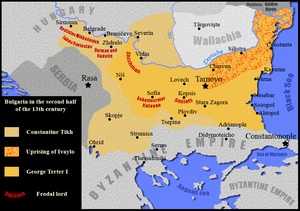- Darman and Kudelin
-
Darman (Bulgarian: Дърман; also Drman, Dǎrman, Durman) and Kudelin (Куделин) were two Bulgarian nobles[1][2] who jointly ruled the region of Braničevo (in modern Serbia) as independent or semi-independent[2] autocrats in the late 13th century (1273–1291). Regarded by historians to be "probably Bulgarians of Cuman origin",[3][4] the two brothers used the weakened state of centralized administration in the region to become independent from the Second Bulgarian Empire[5] or the Kingdom of Hungary[3] in 1273. The capital of their domains was the fortress of Zhdrelo (Ždrelo, "gorge"), on the Mlava river.[1] Relying on their army that consisted of people of various ethnicities, but mostly Bulgarians, Tatars and Cumans,[1] the brothers were "very independent-minded and afraid of no one".[3]
They regularly attacked their western neighbour, the Hungarian vassal Stefan Dragutin's Syrmian Kingdom, in Mačva, an area previously under the sovereignty of Elizabeth of Hungary. The Hungarian queen had sent troops to claim Braničevo in 1282–1284, but her forces had been repelled and her vassal lands plundered in retaliation. Another campaign, this time organized by both Dragutin and Elizabeth, failed to conquer Darman and Kudelin's domains in 1285 and suffered another counter-raid by the brothers. It was not until 1291 when a joint force of Dragutin and Serbian king Stefan Milutin managed to defeat the brothers and, for the first time ever, the region came under the rule of a Serb, as it was annexed by Dragutin.[3][1] The brothers were most likely killed in this campaign, as they disappear from the historical sources thereafter.[5]
Darman and Kudelin were relatives or close associates of the Bulgarian despotēs Shishman of Vidin, the founder of the Shishman dynasty of Bulgarian rulers, as he proceeded to attack the Serbian domains to his west, presumably as a response to Dragutin's annexation of the neighbouring Braničevo.[3]
References
- ^ a b c d Ćorović, Vladimir (2001). "Srbija kao glavna balkanska država" (in Serbian). Istorija sprskog naroda. Belgrade: Janus. http://www.rastko.org.rs/rastko-bl/istorija/corovic/istorija/3_5_l.html.
- ^ a b Радовановић, Љубиша; Милорад Ђорђевић. "Резиме" (in Serbian). Хомоље: историјска монографија. Удружење историчара Браничева и Тимочке Крајине. http://www.istoricari.org.yu/rezimehomolje.htm.
- ^ a b c d e Fine, John V.A. (1987). The late medieval Balkans: a critical survey from the late twelfth century to the Ottoman Conquest. Ann Arbor: University of Michigan Press. pp. 220–221. ISBN 9780472100798. OCLC 13860868.
- ^ Cawley, Charles (2006). "Serbia". Medieval Lands: a prosopography of medieval European noble and royal families. Foundation for Medieval Genealogy. http://fmg.ac/Projects/MedLands/SERBIA.htm.
- ^ a b Бакалов, Георги; Милен Куманов (2003). "Дърман (краят на XIII в.); Куделин (втората половина на XIII в.)" (in Bulgarian). Електронно издание "История на България". София: Труд, Сирма. ISBN 9844830679.
Categories:- Bulgarian nobility
- 13th-century births
- 1291 deaths
- 13th-century Bulgarian people
- Medieval Bulgarian military personnel
- 13th century in Serbia
Wikimedia Foundation. 2010.

